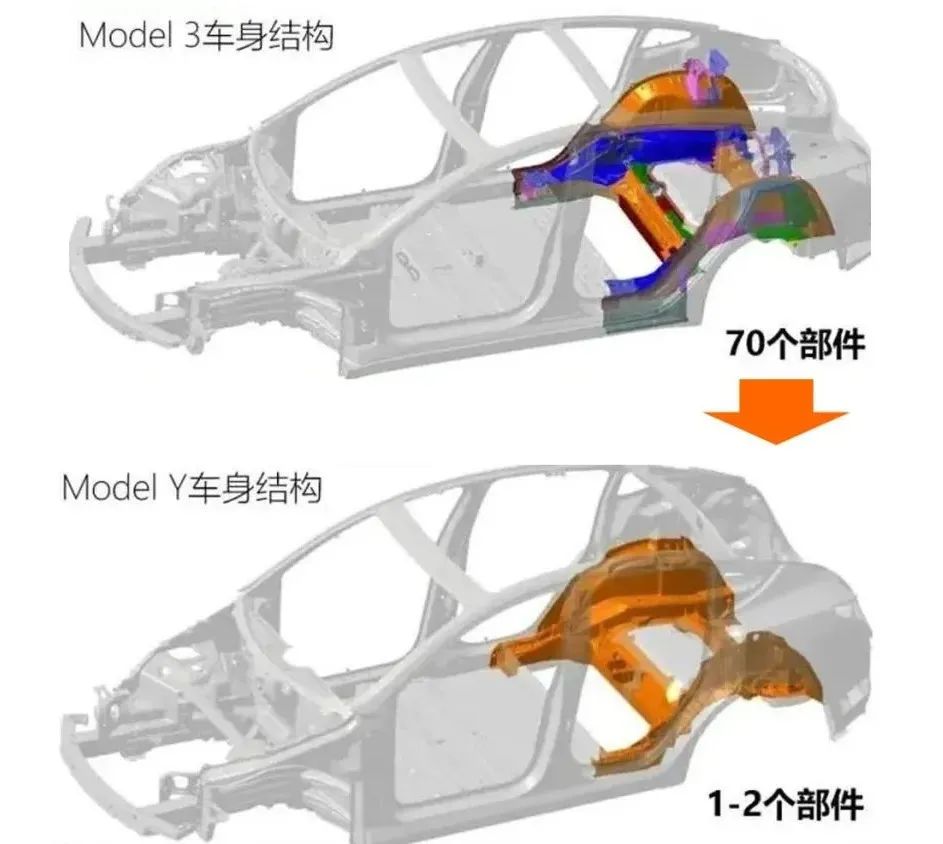Tesla leads the car body revolution, reducing 70 parts to one!
2021.03.02
In February, Tesla shared its Model Y production line at the Shanghai Super Factory on Weibo. What's different is that a super large die-casting machine is installed in the production line, which can produce large-scale automobile die-casting parts. The original 70 parts have been successfully combined into two large parts, and they will even be combined into one in the future. Tesla CEO Musk claimed that this will be "a revolution in auto body engineering."
An engineering perspective drawing from Tesla shows that: Compared with the 70 parts required for Model 3, the entire rear bottom of Model Y consists of only 2 parts:

The body will be drastically reduced from 70 parts to 1-2 casting parts, the body floor will be reduced in weight, the welding process will be streamlined, and the complexity will be simplified, which can better improve product consistency. The capital expenditure for all robots to assemble these parts will be significantly reduced, and the production cycle will be shorter, making it more suitable for mass production.
The production efficiency of the die-casting process is high. The high-speed and high-pressure filling can hydraulically insert the metal into the model in a short time, and it can produce parts with complex shapes, clear outlines, and thin-walled deep cavities. Are there any disadvantages to one-piece die-casting? The die-casting process is not without its shortcomings, which is why it has not been widely used in the automotive field.
First of all, super-large die-casting machines and die-casting molds are very expensive. If there is no scale benefit brought by mass production, it is difficult for car companies to bear the overall cost; due to high-speed filling and rapid cooling, if the gas in the cavity is too late to be discharged, pores and The presence of oxidized inclusions will reduce the quality of die castings.
Previous:What are the arc welding functions and technologies of modern robots?
Next:EMAG's grainless cutting technology: fast, precise and reliable
Related Information
- Industry news
- The tap or drill bit breaks in the hole, how to fix it?
- Why do airplanes use rivets instead of welding?
- Why are engineering drawings all blueprints?
- How is a ping pong ball made? It turns out that it is made of two pieces of plas
- What to do if quality is abnormal? Doing these 3 things well is the key!
- Weekly News 9.7-9.13
- Huawei's three-fold screen is approaching, and the domestic supply chain is wait
- Innovative application of digital twin technology in integrated die-casting prod
- 5 types of carbide cutting tools, what are the differences? Save this article an
- Global manufacturing PMI in June was 49.5% | Weekly News 7.6-7.12
- Raw material defects | Machining special operations and practical cases 109
- No wonder Toyota stamping is so good: a day in the life of a Toyota stamping sho
- Analysis on the development trend and demand of China's mold industry
- How many types of sealing rings are there in machinery? What are they used for?
- Hangfa, Hangfa, a scar on the hearts of machine processing workers
- How to mill a large arc surface with a small cutter?
- Dynamics of the processing center of the process! What is the fundamental reason
- 500 ° C ultra -strong aluminum alloy! This problem is overcome
- How much do you know about the hometown of machine tools and molds, how much do

 BACK
BACK MT HOME
MT HOME Navbar
Navbar